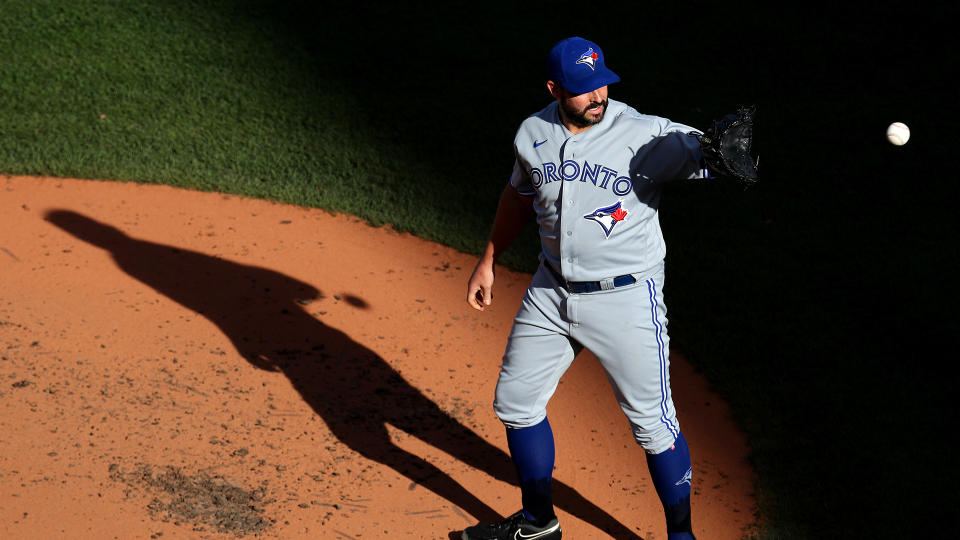Tanner Roark's struggles magnify Blue Jays' biggest flaw
As the Toronto Blue Jays approach their first postseason berth since 2016, one question dominates the discussion surrounding the team.
How is this club going to put together a playoff rotation?
That’s a quandary every team that plays October baseball faces, normally because they’ve used five starters all season and need to figure out who to demote. There’s also consideration given to whether a bullpen game of some kind is a better bet than their back-of-the rotation options.
For the Blue Jays, the question arises for a different reason. This team has no concerns about demoting worthy candidates — they’re looking for anyone capable of filling a spot. That’s especially damning considering the new MLB playoff format means their first, and possibly only, playoff series is just three games long. There aren’t many winning clubs that can’t cobble together three starters, but that’s where the Blue Jays are.
As a result, for the last couple of weeks there have been constant musings of who the Blue Jays can line up behind ace Hyun-Jin Ryu. Maybe it’s Taijuan Walker, who’s only allowed three earned runs in 17.1 innings as a Blue Jay but has dealt with command issues. Maybe it’s Robbie Ray, who looked excellent last time out, but is in the midst of a rough season. Perhaps it’s one of those two, and a bullpen game led by Julian Merryweather, or a returning but still limited Matt Shoemaker. That puzzle becomes even harder to solve if the Blue Jays make it another round to the ALDS — a five-game series with no offdays.
Through all of the speculation, there’s one name that hasn’t been so much as whispered: Tanner Roark.

If you sign a player to a two-year contract worth $24 million, the assumption is that he fits somewhere in your rotation plans when the games matter. Roark was never billed as a top-of-the-rotation arm, but he was supposed to be a reliable presence, which coincidentally is exactly what the Blue Jays need right now.
Instead, the 33-year-old has posted an ERA of 6.41 with a truly-ugly FIP of 7.71 in 39.1 innings. He hasn’t given his team more than five innings in any start, and his HR/9 of 3.20 is second to the imploding Madison Bumgarner among the 118 pitchers who’ve logged 30 or more innings this year. His walk rate (4.81 BB/9) is a career high, and ranks 114th in that same group.
Theoretically, you could make a case that this is a small sample and Roark’s long track record of providing solid innings indicates he’ll bounce back. The problem with that argument is that it ignores brutal underlying numbers and material changes to the right-hander’s stuff.
From a Statcast perspective, he ranks in the 10th percentile or below in Barrel Percentage, Expected ERA, Expected Slugging Percentage and Expected wOBA. His batting average on balls in play against (.312) is actually lower than it was last year (.322), so he’s not experiencing bad luck with balls dropping in. Even the lofty home run totals he’s allowed are earned as his xHR of 13.7 matches his real total 14.
The results have been awful, and there’s nothing in there to suggest they should be better. Arguably the bigger problem is the deterioration of his stuff.
Roark didn’t come to the Blue Jays billed as a power pitcher, but his fastball has lost some zip and it’s made an enormous difference:

Not only has he lost velocity, the movement on Roark’s pitches has been noticeably worse in 2020. When it comes to vertical movement, he’s seen less depth on his slider while his sinker has less sink.

The situation is even more grim when it comes to horizontal movement, where Roark has seen a decline on everything except his slider.

So in summary, Roark has performed extremely poorly, with the peripherals to match, while seeing the quality of his pitches decline in a significant and quantifiable way. There’s quite literally no reason for optimism here.
While a rebound in 2021 is not technically impossible, the smart money is on the Roark signing being a major misstep for the Blue Jays — one that’s magnified significantly by their current situation.
Sometimes when you invest in a “reliable” middle-market free agent, what you’re really getting is a declining player who gets by on slim margins that age can quickly erode. That’s what the Blue Jays found with Kendrys Morales in 2017, and it’s starting to look like they’re in the same boat with Roark.
More Blue Jays coverage from Yahoo Sports

 Yahoo Movies
Yahoo Movies 


